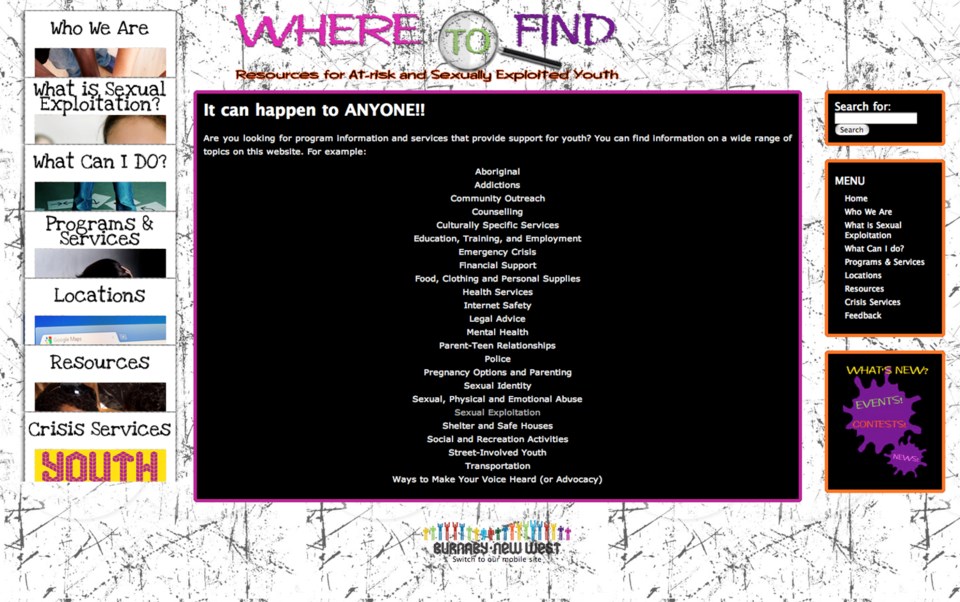Exploited and at-risk youth numbers in Burnaby and New Westminster have risen, according to the 2013 count.
Over the month of February, the data collected from service providers in both Burnaby and New Westminster recorded how many children and youth were already in the sex trade, were suspected of being in it or at high risk of getting involved.
Two years after doing the first count, the Burnaby-New Westminster Task Force on Sexuality Exploited and At-Risk Youth tracked 217 youth – up from the 146 counted in 2011 – either being sexually exploited or at risk of it. The task force provided a checklist to service providers in the two communities to track the youth either being exploited or on their way. The task force defines exploitation as the exchange of sexual acts for food, a ride, shelter, drugs, alcohol, money or to fit in.
Fifty-seven per cent of the youth were from Burnaby, 30 per cent from New Westminster and the rest counted came from other areas.
“One of our slogans is, it can happen to anyone,” Joan Selby, a City of Burnaby senior social planner, told The Record. “Any kid can be vulnerable. The ones that are preyed on tend to have a lack of self confidence, they may have some trauma happening in their life.”
In all, 25 youth were confirmed as being sexually exploited – 20 per cent under the age of 15. Forty-six youth were suspected, and 141 youth were considered at risk.
“There isn’t a stereotype of the kind of kid,” Selby added. “All kids sometimes suffer from a lack of self-esteem, when they’re in that phase, that’s suddenly when they’re recruited. They’re going to parties and they just fall in. Also, kids who aren’t popular in school, now they feel like they belong.”
Eighty-six per cent of those counted were girls. Of the 217, 71 were younger than 15 years old, which is up 16 per cent from 2011. Eighty-one per cent were under 17. The rest were between the ages of 18 and 25.
Selby said the task force speculates that the increase in numbers, and the lower age recorded, is due to more organizations being involved in the 2013 count than before. For instance, the Burnaby school district participated this time around.
“That would put newcomers, refugee or immigrant kids particularly at risk,” Selby added, about students seeking popularity. “They want to try to fit in, same with LGBTQ – sometimes they’re bullied and not accepted. … A lot of the recruitment is done by peers in their same age group, but a lot of the control is from predators or pimps who send them out.”
A majority of the youth still live at home, 62 per cent, while 83 per cent still attend school – at least sometimes. Almost half of those who do attend go to school regularly.
The youth counted come from an array of ethnicities, as well: 40 per cent were Caucasion (down from 54 per cent in 2011), 14 per cent were aboriginal, seven per cent were Asian, three per cent were black, and three per cent were Hispanic or Latino. The rest were categorized as unknown.
“It’s about exploitation,” Selby said. “There’s an exploitation going on, so the kid is trading sex for cigarettes, a ride, food. One of the issues for us is a lot of the kids don’t see that, as long as they’re not taking money. They don’t see it as an issue.”
As far as doing drugs or drinking alcohol, 103 youth (47 per cent) admitted to doing so.
“They have issues. It could be drugs, and that’s why we changed our names to be at-risk because all of those factors enter in,” said Burnaby Coun. Colleen Jordan, who is also involved with the task force. “If they’re homeless, if they’re couch surfing, if they’re doing drugs. Some of this all leads to the potential of being exploited sexually.”
The count also showed five of the 71 confirmed youth under 15 years old were boys.
Jordan and Selby both stressed, however, that these are only the children they are aware of.
“There’s all kinds of reasons kids don’t come in contact with the system,” Selby said. “One is they don’t think they have an issue. Two, there’s language, cultural barriers. Three, there’s shame.”
Another setback to obtain accurate numbers and keep tabs of what’s really happening is the continued underground push of youth being exploited over the Internet by “boyfriends” or pimps.
“We looked at what it was last time, the trend away from street exploitation to Internet and it seems to be continuing,” Jordan added. “They’re on sugardaddie.com. Look it up, it’s pretty scary.”
Selby said the count was done anonymously as no names were collected, but the task force tried to make sure youth were not counted by more than one agency.



